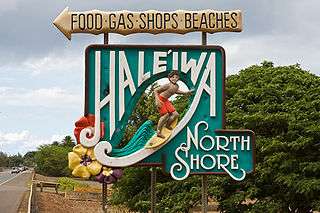North Shore (Oahu)

The North Shore, in the context of geography of the Island of Oʻahu, refers to the north-facing coastal area of Oʻahu between Kaʻena Point and Kahuku Point.
The largest settlement is Haleʻiwa. This area is best known for its massive waves, attracting surfers from all around the globe.
Surfing
.jpg)
The northern hemisphere winter months on the North Shore see a concentration of surfing activity, taking advantage of swells originating in the stormy North Pacific. Notable surfing spots include Waimea Bay and Sunset Beach.
The spot of Ehukai Beach, commonly known as the Banzai Pipeline, is the most notable surfing spot on the North Shore, and is considered a prime spot for competitions due to its close proximity to the beach, giving spectators, judges, and photographers a great view.
The North Shore is considered to be the surfing mecca of the world, and every December hosts three competitions, which make up the Triple Crown of Surfing. The three men's competitions are the Reef Hawaiian Pro, the O'Neill World Cup of Surfing, and the Billabong Pipeline Masters. The three women's competitions are the Reef Hawaiian Pro, the Roxy Pro Sunset, and the Billabong Pro on the neighboring island of Maui.[1]
Waimea Bay plays host to the Quiksilver Big Wave Invitational in Memory of Eddie Aikau. This is an exclusive competition and participants must be invited. The competitions has a scheduled window of dates each winter, however the competition has a minimum requirement of 20-foot (6.1 m) waves. Therefore, the competition is not held every year.
Learning to surf
Although the North Shore is known for its large winter surf, there are a number of surf schools that can teach a beginner the basics of surfing in coves that are protected from the larger waves.
Television and film

Due to its natural beauty, proximity to Honolulu, and large waves, the North Shore is a popular area for filming.
The Fox Network TV show North Shore was filmed there. ABC's Lost was filmed almost entirely on O'ahu, with much of it filmed on the North Shore. The area of Turtle Bay features rock formations and constant rolling surf, making it ideal as a backdrop for Lost.
The North Shore was also the setting for the movies Ride the Wild Surf, North Shore, Blue Crush, The Big Bounce, and Forgetting Sarah Marshall, as well as being fictionalized for the animated film Surf's Up.
The sixth episode of the first season of the CBS series Hawaii Five-0 was set on the North Shore and titled "Koʻolauloa", the Hawaiian-language term for the area.
Accommodation
The North Shore only houses one large commercial hotel, the Turtle Bay Resort, which also has 2 world-class golf courses. Other accommodations are available in privately run condos, house rentals, and a youth hostel.[2]
Notable residents
- Rochelle Ballard, professional surfer
- Owl Chapman, surfer
- Darrick Doerner, surfer
- Jim Evans, artist
- John John Florence, professional surfer
- Brian Grazer, Oscar-winning film and television producer[3]
- Bruce Irons, professional surfer
- Jack Johnson, folk rock singer-songwriter
- Samuel Kamakau, historian
- Clark Little, photographer
- Jamie O'Brien, professional surfer[4]
- Frederick Patacchia, professional surfer
- Makua Rothman, professional surfer
- Paul Theroux, American travel writer and novelist[5]
- Butch Van Artsdalen, surfer
References
- ↑ "2012 Vans Triple Crown of Surfing hydrated by vitaminwater". Triplecrownofsurfing.com. Retrieved January 3, 2013.
- ↑ Backpackers Vacation Inn and Plantation Village
- ↑ Tom Austin (July 2006). "Surfing Oahu's North Shore; Oahu's North Shore Scene". Travel + Leisure. Retrieved January 3, 2013.
- ↑ George, Sam. "Hawaiian: The Legend of Eddie Aikau". IMDB.com. ESPN (2013). Retrieved 3 April 2015.
- ↑ "Theroux: No Place Like Home". CBS: Sunday Morning. August 3, 2001. Retrieved December 15, 2015.
External links
| Wikivoyage has a travel guide for North Shore (Oahu). |
- Oʻahu North Shore, Be Our Guest Directory
- Oʻahu Surf Conditions, Radar, and Forecasts
- 'Life Among The Swells': William Finnegan from Outside magazine gives a detailed insight into the professional surfing world on the North Shore of Oʻahu.
- Oʻahu North Shore Chamber of Commerce
- "The Drive-By Coast." Hana Hou! Vol. 10, No. 2 (April/May 2007 issue; 7 pages). Article by Curt Sanburn, photographs by Dana Edmunds.
Coordinates: 21°37′11″N 158°05′08″W / 21.6197°N 158.0856°W